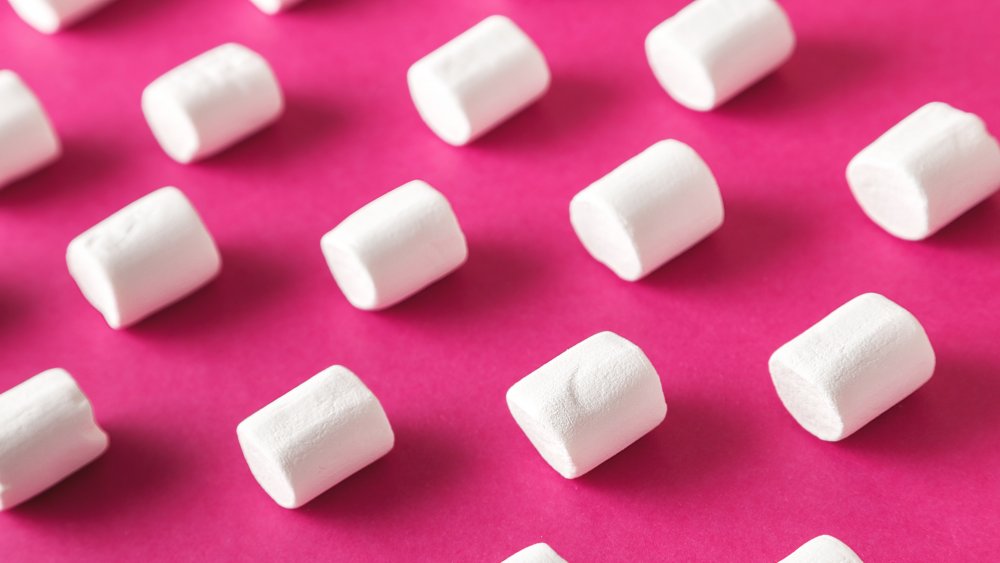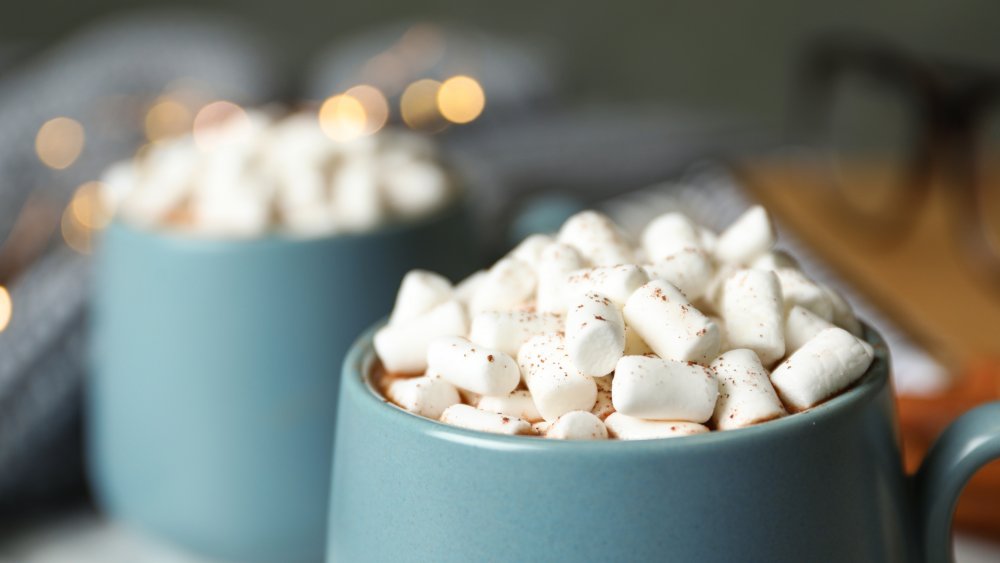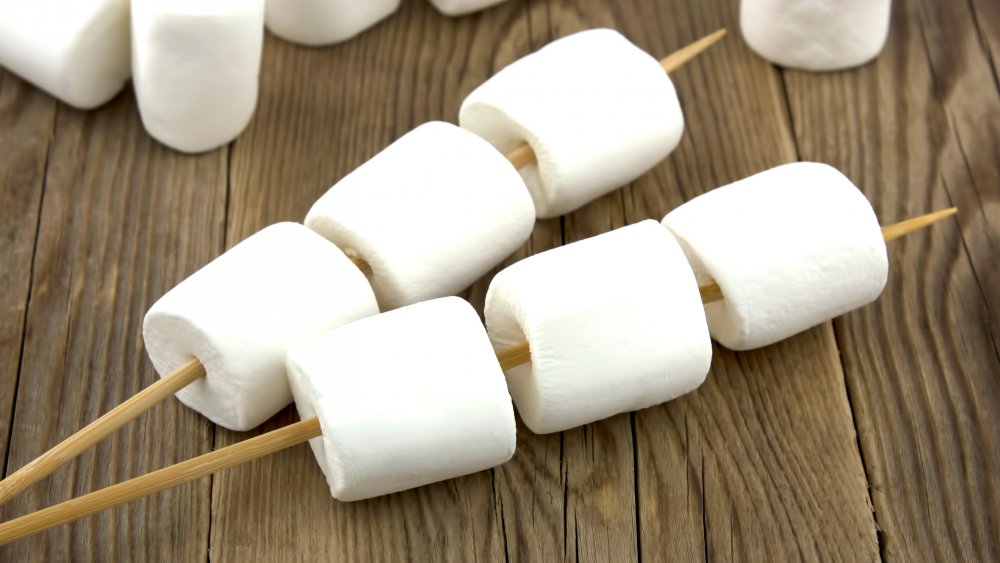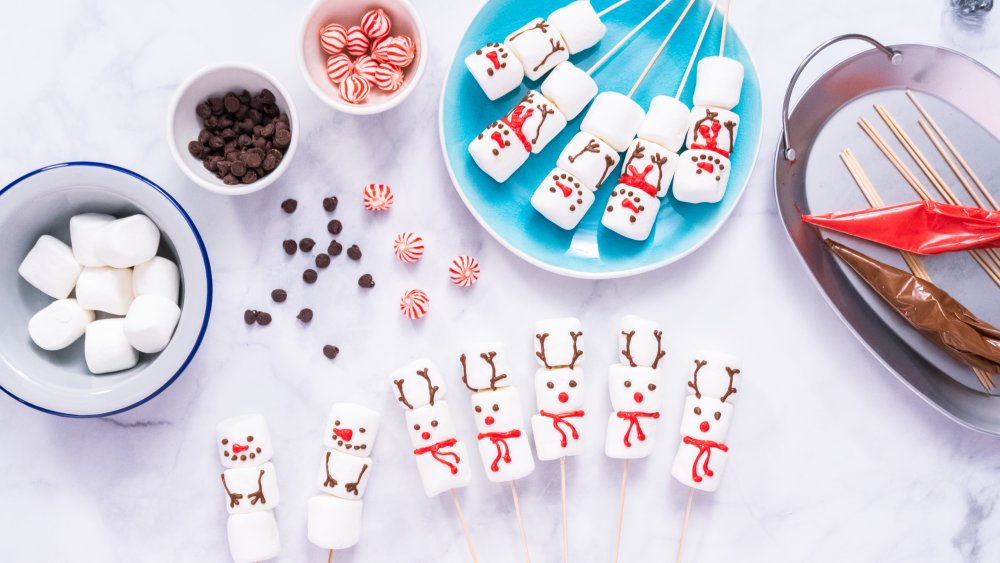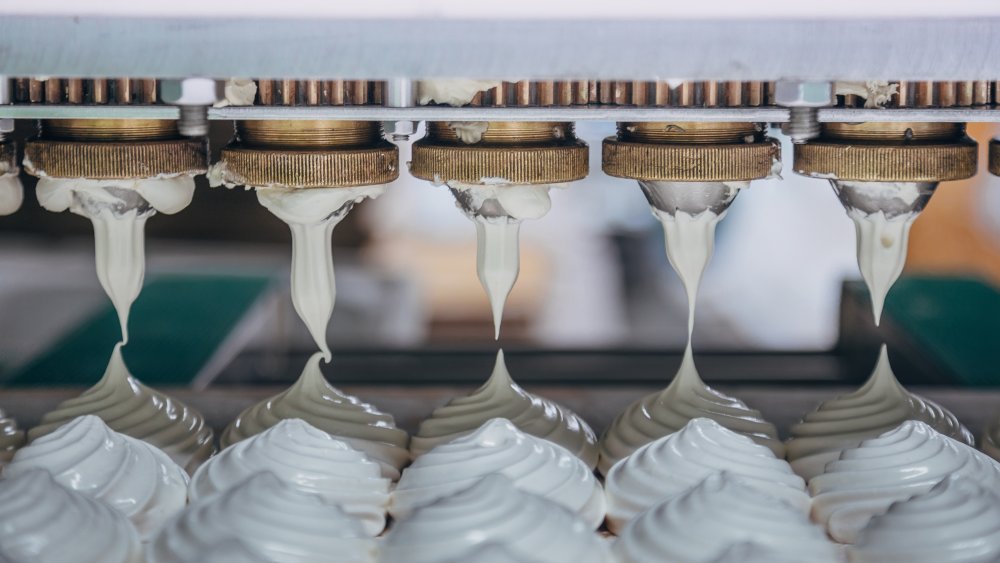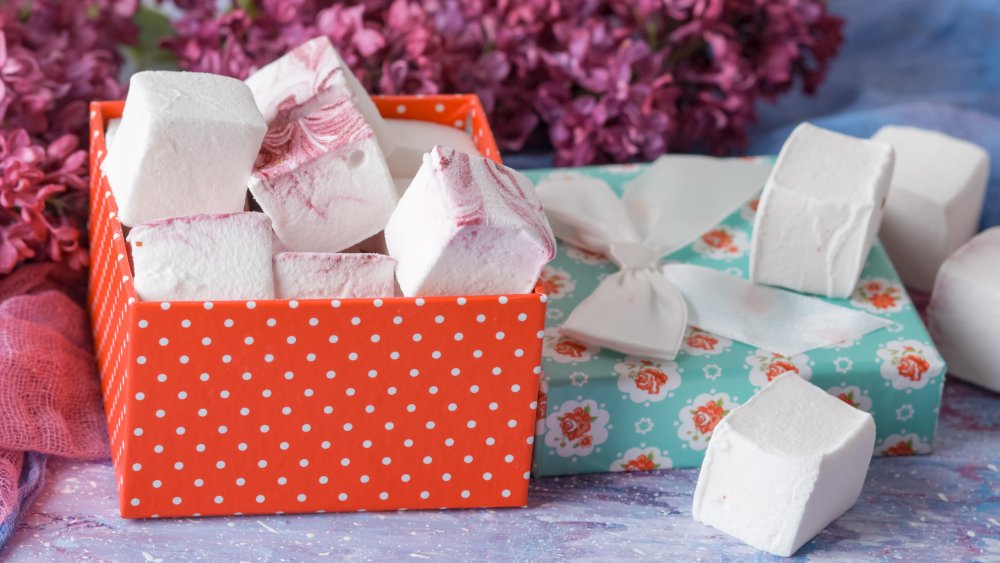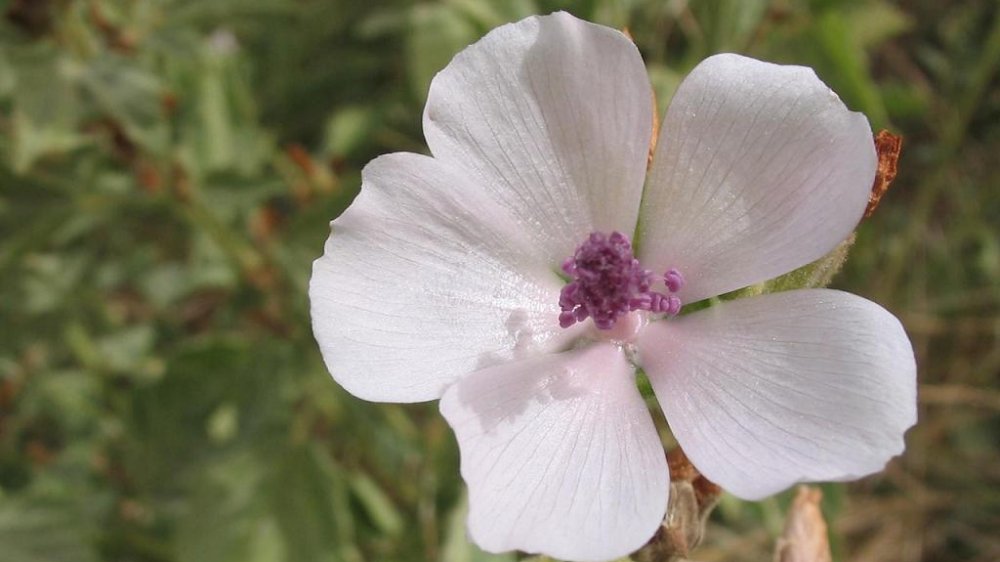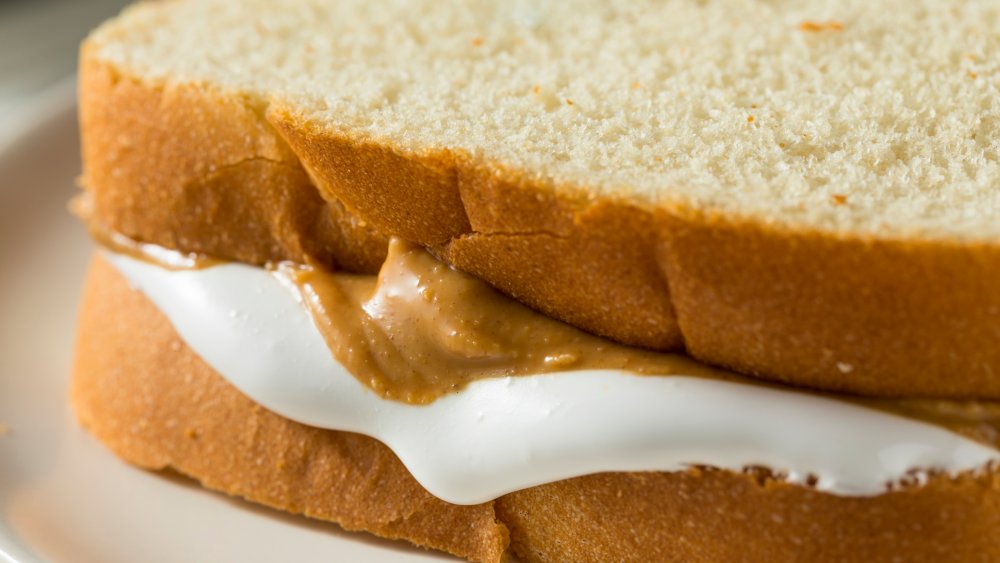This Is How Marshmallows Are Really Made
There are plenty of childhood favorites we outgrow, but you're never, ever too old for marshmallows. Whether you're piling them on top of your hot chocolate, making s'mores by the campfire with your own children (or in the microwave after a particularly rough day), or hiding Peeps in a place they'll stay hidden until they go stale, marshmallows are undeniably delicious.
They're also pretty weird, soft, fluffy treats that are just the right amount of sweet and oddly comforting. No Thanksgiving dinner is complete without them! You can make them yourself, if you're looking for a fun, rainy day project, but you just can't duplicate the ones that come out of the bag.
How do they make those heavenly little marshmallow treats, anyway? What are we really eating? And is there a difference between the ones you make at home and the bag you just can't resist picking up at the store? Strangely, it's a tale that's centuries in the making.
The most common marshmallow ingredients
Americans do love their marshmallows, and it's kind of mind-blowing just how much of the stuff we eat. As a nation, the National Confectioners Association says that around 90 million pounds of marshmallow are sold every year. That's a ton of the light, fluffy little pillows, and to put it in an even more impressive perspective, that's about the same weight as 1,286 gray whales.
So, what exactly are we eating? The American Chemical Society says that the ingredients in most marshmallows is about what you'd expect. You have your sugar, corn syrup, modified cornstarch, and gelatin — and air is so important to the process that we're going to call it an ingredient, too. You can't have that pillowy texture without it, after all!
Pretty straightforward, right? Some types of marshmallows might also have some coloring or flavoring added, too, but for the most part, that's what you're eating when you're loading up your hot cocoa with the finishing touches that make it oh-so-comforting on a cold afternoon.
Why is the gelatin so important in marshmallows?
Most of the ingredients in marshmallows are pretty well-known... and then there's gelatin. Gelatin is incredibly important to the process, says the American Chemical Society, because it's what gives marshmallows that fluffy, elastic, squishy texture. Food scientists say that when all the ingredients are whipped together, gelatin essentially acts to bind liquid into the mixture. That creates the fluffy foam that becomes your marshmallow, and it also has another benefit: it acts to extend the shelf life of the product. Marshmallows can kick around in the cabinet for up to 24 months and still be perfectly fine, so if you like your Peeps when they're a little on the mature side, thank gelatin.
So, what is gelatin? Here's where things get yucky. According to Healthline, it's made by cooking collagen, which is the connective tissue found in things like bones, ligaments, and skin. Those are generally the parts of an animal that we don't eat, so instead of going to waste, those parts are boiled to make gelatin. It's high in protein and does contain vital amino acids, so... that makes marshmallows practically a vitamin supplement, right?
Marshmallows start with mixing and beating
So, let's get down to the how-to. According to How Products Are Made, there are two types of ingredients that go into marshmallows (and the specifics can vary by brand) — emulsifying agents and sweeteners. Sweeteners are stuff like sugar and corn syrup, and that's what gives the marshmallows their flavors. Emulsifiers are what act to create that distinctive texture. To make a marshmallow, well, a marshmallow, it's got to be able to hold its shape while still incorporating a lot of air — and emulsifiers are how that happens.
The whole marshmallow-making process usually starts by mixing sugar, corn syrup, and water, then bringing it to a boil. The gelatin is added at this point, and after the mixture is strained, it's whipped — a lot.
The whipping process is incredibly important, and at this point, the mixture will turn foamy and double or triple in size thanks to the air that enters the mixture. It's also at this point that any flavoring is added. Surprisingly, by this time, the hard part's done.
Today's marshmallows are all about the extrusion process
Marshmallows have been made for a long time, and before extrusion was added to the process in the 1950s, marshmallow shaping was done by hand. According to The New York Times, it was a labor- and time-intensive process. The mixture would have to "sweat" for a couple of hours, and it was during that time that it would form that outer layer that holds the whole thing together. After sitting, it would be sprinkled with a layer of starch, then packaged and sold.
But that all changed with a process that was the brainchild of Alex Doumak. He came up with the idea of treating the goopy, raw marshmallow "dough" as though it was something more industrial than food, and he ultimately developed the extrusion machine that's still used today.
Basically, the raw material is pushed through long tubes that don't just form it into circular shapes, but put it under extreme pressure: 200 pounds of pressure per square inch, to be precise. By the time it gets to the end of the machine, it's essentially formed long whips of marshmallows — light, fluffy marshmallows, no wait time required. Those are then sliced into the bite-sized morsels we all know and love, in a fraction of the time it used to take. This method is sometimes called jet-puffed, a term you may familiar with when it comes to marshmallows.
When it comes to other shapes or marshmallows, the same principles are at work: machinery and pressure.
What's the difference between store-bought and homemade marshmallows?
Gone are the days where the only marshmallows you can find are the ones in the bags at the grocery store. According to The Washington Post, pastry chefs across the country are embracing the marshmallow as something sweet and delicious they can put their own spin on by making it themselves.
These marshmallows often add egg whites into the mix, and Peter Brett, pastry chef at Washington's Park Hyatt Hotel, had this to say about small batch marshmallows: "A homemade marshmallow is really a revelation. [...] It's like magic, simple syrup turning into marshmallow."
How realistic is it to try to make them yourself? NPR spoke to Jennifer Reese, an author who decided to try all these make-at-home projects most of us just say we're going to get around to someday. She says making marshmallows at home isn't particularly difficult, and although it's not cheaper than buying the store-bought ones, taste tests suggest they're creamier, more flavorful, and worth the effort.
The process is much the same — boil your ingredients, whip into a foam, then let it set in a cookie sheet before cutting into puffs. Best of all? You can make your marshmallows as big as you want.
Marshmallows were originally made very, very differently
People have been enjoying marshmallows for a really long time — all the way back to ancient Egypt. Those original marshmallows were made differently, though... but they do sound delicious. According to ThoughtCo., honey was the original sweetener, and it was sap from the marsh-mallow plant that was used to thicken the candies.
Marsh-mallow plants were, as their name suggests, harvested from alongside large bodies of water. They were used well into the 19th century, when the sap was removed, cooked with egg whites and sugar, then whipped. These original marshmallow candies were also medicinal, used to treat sore throats and cough. Any healing properties were attributed to the marsh-mallow sap, though, and once the recipe changed, so did their role.
So, here's a question: were those original marshmallows really medicinal, or was it another quack remedy? According to Medical News Today, there have been studies that seem to confirm the root of the marshmallow plant can be used to successfully treat coughs, chronic dry mouth, skin irritation, and it may also speed wound healing. Maybe we should go back to the old way?
The recipe for marshmallow fluff is pretty similar
So what about marshmallow fluff? We all know that there's nothing quite like a fluffernutter sandwich, and it certainly tastes just like marshmallow... so, what's the difference in the recipe?
According to the American Chemical Society, there's not much. Egg whites used to be used in most standard marshmallow recipes, but that's been dropped from most commercial versions. It is, however, still used in marshmallow fluff, and that's what gives it that ooey, gooey texture.
Marshmallow fluff — or marshmallow creme — was actually invented in the 1890s, and it, too, was originally medicinal... in a very weird way. One company sang its praises as a wrinkle remover, and if you get people to smear that on their faces, that's some brilliant marketing!
But the marshmallow fluff we know and love today is a little different, and Mental Floss says it was developed in 1917 by Archibald Query. It uses just four things: dried egg whites, sugar, corn syrup, and vanilla (although commercial versions have swapped in other versions of the same products, like replacing the vanilla with vanillin). Now you know!
